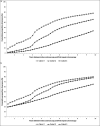Follow-up of 3 Million Persons Undergoing Colonoscopy in Germany: Utilization of Repeat Colonoscopies and Polypectomies Within 10 Years
- PMID: 33464730
- PMCID: PMC8345921
- DOI: 10.14309/ctg.0000000000000279
Follow-up of 3 Million Persons Undergoing Colonoscopy in Germany: Utilization of Repeat Colonoscopies and Polypectomies Within 10 Years
Erratum in
-
Correction to: Follow-Up of 3 Million Persons Undergoing Colonoscopy in Germany: Utilization of Repeat Colonoscopies and Polypectomies Within 10 Years.Clin Transl Gastroenterol. 2024 Feb 1;15(2):e00677. doi: 10.14309/ctg.0000000000000677. Clin Transl Gastroenterol. 2024. PMID: 38407275 Free PMC article. No abstract available.
Abstract
Introduction: Given the sparsity of longitudinal studies on colonoscopy use, we quantified utilization of repeat colonoscopy within 10 years and the proportion of persons with polypectomies at first repeat colonoscopy using a large German claims database.
Methods: Based on the German Pharmacoepidemiological Research Database, we identified persons who underwent colonoscopy between 2006 and 2015 (index colonoscopy) and assessed colonoscopies and polypectomies during follow-up. We defined 3 subcohorts based on available procedure/diagnosis codes at index colonoscopy: persons with snare polypectomy, which is reimbursable for lesions ≥5 mm in size (cohort 1), with a forceps polypectomy (cohort 2), and without such procedures/diagnoses (cohort 3). We stratified all analyses by diagnostic vs screening index colonoscopy.
Results: Overall, we included 3,076,657 persons (cohort 1-3: 15%, 13%, 72%). Among persons with screening index colonoscopy (30%), the proportions with a repeat colonoscopy within 10 years in cohorts 1, 2, and 3 were 78%, 66%, and 43%, respectively, and a snare polypectomy at first repeat colonoscopy was performed in 27%, 17%, and 12%, respectively. In cohort 1, 32% of persons with a (first) repeat colonoscopy after 9 years had a snare polypectomy (after 3 years: 25%). Among persons with diagnostic index colonoscopies, 80%, 78%, and 65% had a repeat colonoscopy, and 27%, 17%, and 10% had a snare polypectomy at first repeat colonoscopy, respectively.
Discussion: Our study suggests substantial underuse of repeat colonoscopy among persons with previous snare polypectomy and overuse among lower risk groups. One-quarter of persons with a snare polypectomy at baseline had another snare polypectomy at first repeat colonoscopy.
Copyright © 2020 The Author(s). Published by Wolters Kluwer Health, Inc. on behalf of The American College of Gastroenterology.
Conflict of interest statement
Figures


Similar articles
-
Polyp detection rate and cumulative incidence of post-colonoscopy colorectal cancer in Germany.Int J Cancer. 2023 Apr 15;152(8):1547-1555. doi: 10.1002/ijc.34375. Epub 2022 Dec 7. Int J Cancer. 2023. PMID: 36444495
-
Rates of Incomplete Resection of 1- to 20-mm Colorectal Polyps: A Systematic Review and Meta-Analysis.Gastroenterology. 2020 Sep;159(3):904-914.e12. doi: 10.1053/j.gastro.2020.05.018. Epub 2020 May 8. Gastroenterology. 2020. PMID: 32437747
-
Colonoscopy With Polypectomy Reduces Long-Term Incidence of Colorectal Cancer in Both Men and Women: Extended Results From the Minnesota Colon Cancer Control Study.Gastroenterology. 2021 Mar;160(4):1397-1399.e3. doi: 10.1053/j.gastro.2020.11.014. Epub 2020 Nov 17. Gastroenterology. 2021. PMID: 33217449 Clinical Trial. No abstract available.
-
Screening colonoscopy for colorectal cancer prevention: results from a German online registry on 269000 cases.Eur J Gastroenterol Hepatol. 2009 Jun;21(6):650-5. doi: 10.1097/meg.0b013e32830b8acf. Eur J Gastroenterol Hepatol. 2009. PMID: 19445041
-
Cold polypectomy techniques for diminutive polyps in the colorectum.Dig Endosc. 2014 Apr;26 Suppl 2:98-103. doi: 10.1111/den.12252. Dig Endosc. 2014. PMID: 24750157 Review.
Cited by
-
A mobile app to improve adherence to colorectal cancer screening and post polypectomy surveillance guidelines.BMC Gastroenterol. 2025 Mar 27;25(1):203. doi: 10.1186/s12876-025-03796-0. BMC Gastroenterol. 2025. PMID: 40148816 Free PMC article.
-
Measuring and Improving Quality of Colonoscopy for Colorectal Cancer Screening.Tech Innov Gastrointest Endosc. 2022;24(3):269-283. doi: 10.1016/j.tige.2021.11.002. Epub 2021 Nov 14. Tech Innov Gastrointest Endosc. 2022. PMID: 36778081 Free PMC article.
References
-
- Chen C, Läcke E, Stock C, et al. . Colonoscopy and sigmoidoscopy use among older adults in different countries: A systematic review. Prev Med 2017;103:33–42. - PubMed
-
- Stock C, Haug U, Brenner H. Population-based prevalence estimates of history of colonoscopy or sigmoidoscopy: Review and analysis of recent trends. Gastrointest Endosc 2010;71:366–81. - PubMed
-
- Bunjo Z, Koh YH, Leopardi L, et al. . Surveillance colonoscopies frequently booked earlier than the National Health and Medical Research Council guidelines: Findings of a single centre audit. ANZ J Surg 2019;89:E61–5. - PubMed
Publication types
MeSH terms
LinkOut - more resources
Full Text Sources
Medical

